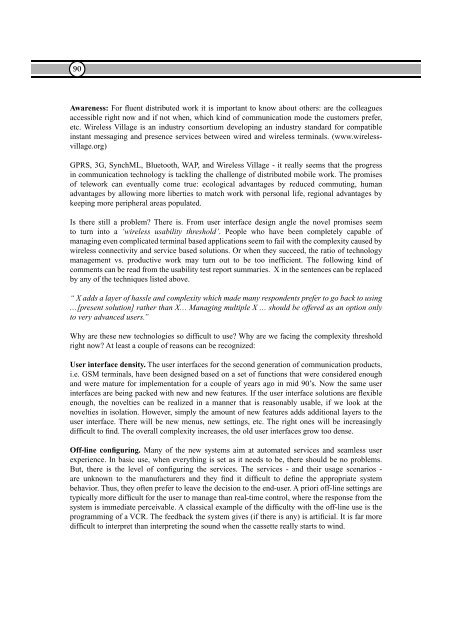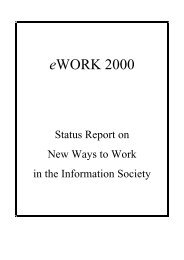Proceedings of 8th European Assembly on telework (Telework2001)
Proceedings of 8th European Assembly on telework (Telework2001)
Proceedings of 8th European Assembly on telework (Telework2001)
You also want an ePaper? Increase the reach of your titles
YUMPU automatically turns print PDFs into web optimized ePapers that Google loves.
90Awareness: For fluent distributed work it is important to know about others: are the colleaguesaccessible right now and if not when, which kind <str<strong>on</strong>g>of</str<strong>on</strong>g> communicati<strong>on</strong> mode the customers prefer,etc. Wireless Village is an industry c<strong>on</strong>sortium developing an industry standard for compatibleinstant messaging and presence services between wired and wireless terminals. (www.wirelessvillage.org)GPRS, 3G, SynchML, Bluetooth, WAP, and Wireless Village - it really seems that the progressin communicati<strong>on</strong> technology is tackling the challenge <str<strong>on</strong>g>of</str<strong>on</strong>g> distributed mobile work. The promises<str<strong>on</strong>g>of</str<strong>on</strong>g> <strong>telework</strong> can eventually come true: ecological advantages by reduced commuting, humanadvantages by allowing more liberties to match work with pers<strong>on</strong>al life, regi<strong>on</strong>al advantages bykeeping more peripheral areas populated.Is there still a problem? There is. From user interface design angle the novel promises seemto turn into a ‘wireless usability threshold’. People who have been completely capable <str<strong>on</strong>g>of</str<strong>on</strong>g>managing even complicated terminal based applicati<strong>on</strong>s seem to fail with the complexity caused bywireless c<strong>on</strong>nectivity and service based soluti<strong>on</strong>s. Or when they succeed, the ratio <str<strong>on</strong>g>of</str<strong>on</strong>g> technologymanagement vs. productive work may turn out to be too inefficient. The following kind <str<strong>on</strong>g>of</str<strong>on</strong>g>comments can be read from the usability test report summaries. X in the sentences can be replacedby any <str<strong>on</strong>g>of</str<strong>on</strong>g> the techniques listed above.“ X adds a layer <str<strong>on</strong>g>of</str<strong>on</strong>g> hassle and complexity which made many resp<strong>on</strong>dents prefer to go back to using…[present soluti<strong>on</strong>] rather than X… Managing multiple X … should be <str<strong>on</strong>g>of</str<strong>on</strong>g>fered as an opti<strong>on</strong> <strong>on</strong>lyto very advanced users.”Why are these new technologies so difficult to use? Why are we facing the complexity thresholdright now? At least a couple <str<strong>on</strong>g>of</str<strong>on</strong>g> reas<strong>on</strong>s can be recognized:User interface density. The user interfaces for the sec<strong>on</strong>d generati<strong>on</strong> <str<strong>on</strong>g>of</str<strong>on</strong>g> communicati<strong>on</strong> products,i.e. GSM terminals, have been designed based <strong>on</strong> a set <str<strong>on</strong>g>of</str<strong>on</strong>g> functi<strong>on</strong>s that were c<strong>on</strong>sidered enoughand were mature for implementati<strong>on</strong> for a couple <str<strong>on</strong>g>of</str<strong>on</strong>g> years ago in mid 90’s. Now the same userinterfaces are being packed with new and new features. If the user interface soluti<strong>on</strong>s are flexibleenough, the novelties can be realized in a manner that is reas<strong>on</strong>ably usable, if we look at thenovelties in isolati<strong>on</strong>. However, simply the amount <str<strong>on</strong>g>of</str<strong>on</strong>g> new features adds additi<strong>on</strong>al layers to theuser interface. There will be new menus, new settings, etc. The right <strong>on</strong>es will be increasinglydifficult to find. The overall complexity increases, the old user interfaces grow too dense.Off-line c<strong>on</strong>figuring. Many <str<strong>on</strong>g>of</str<strong>on</strong>g> the new systems aim at automated services and seamless userexperience. In basic use, when everything is set as it needs to be, there should be no problems.But, there is the level <str<strong>on</strong>g>of</str<strong>on</strong>g> c<strong>on</strong>figuring the services. The services - and their usage scenarios -are unknown to the manufacturers and they find it difficult to define the appropriate systembehavior. Thus, they <str<strong>on</strong>g>of</str<strong>on</strong>g>ten prefer to leave the decisi<strong>on</strong> to the end-user. A priori <str<strong>on</strong>g>of</str<strong>on</strong>g>f-line settings aretypically more difficult for the user to manage than real-time c<strong>on</strong>trol, where the resp<strong>on</strong>se from thesystem is immediate perceivable. A classical example <str<strong>on</strong>g>of</str<strong>on</strong>g> the difficulty with the <str<strong>on</strong>g>of</str<strong>on</strong>g>f-line use is theprogramming <str<strong>on</strong>g>of</str<strong>on</strong>g> a VCR. The feedback the system gives (if there is any) is artificial. It is far moredifficult to interpret than interpreting the sound when the cassette really starts to wind.








